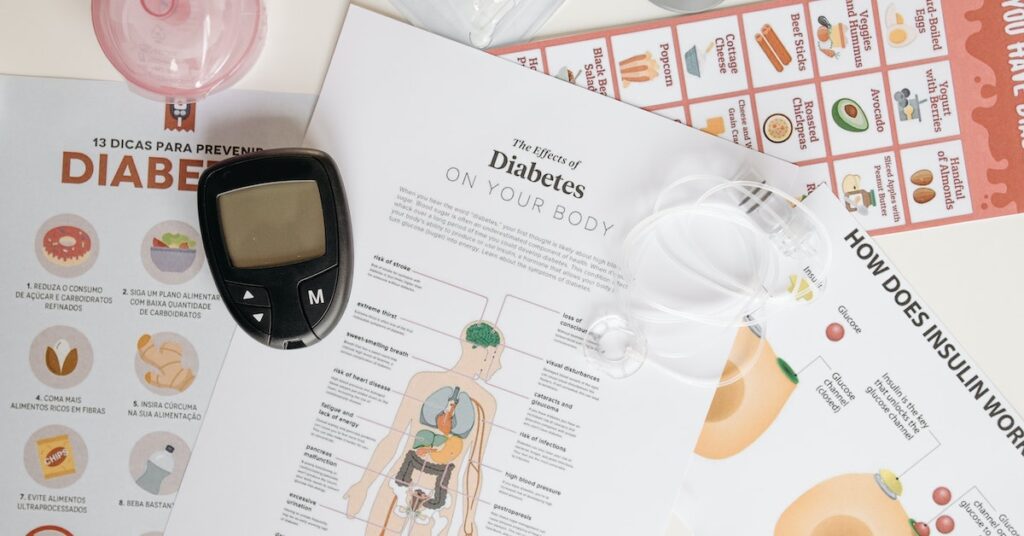Type 2 Diabetes Mellitus: Causes, Symptoms, Risks and Treatment

Type 2 diabetes is a condition that influences the body’s volume to accomplish and use carbohydrate (sweet substance) as fuel. This chronic (long-term) condition causes an excessive quantity of sugar to circulate in the circulation. Excess blood sugar levels may cause cardiovascular, neurological, and immunological system problems over time.
Although type 2 diabetes is more common in the elderly, it has become increasingly common in younger individuals as a result of the growth in childhood obesity.
Food is broken down into its simple elements during digestion. Simple sugars, principally glucose, are formed when carbohydrates are broken down. For the body’s cells, glucose is a vital source of energy. Glucose must go from the blood and enter the cells in order to provide them energy.
The blood-carried insulin instructs the cells to adopt sweet substances. The pancreas produces the birth control method insulin. An organ in the stomach is the pancreas.
The pancreas generates more insulin when blood glucose levels increase (for as following a meal).
When your body’s cells reject insulin’s intended result of pushing blood glucose into the cells’ interiors, type 2 diabetes develops, called insulin resistance. Blood glucose levels start to rise in a suitable way.
Symptoms of Diabetes:
Diabetes symptoms include increased hunger, thirst, fatigue, decreased eyesight, numbness or tingling in the hands or feet, unhealed wounds, and unexplained weight loss.
Numbness or tingling feelings extremities. Darker skin patches, most commonly found in the armpits and neck. Wounds that heal slowly. Infections occur often.
Symptoms of type 1 diabetes may emerge rapidly, within a few weeks. Type 2 diabetes symptoms might arise gradually over time and may be so modest that you are unaware of them. Some crowds are ignorant they have diabetes as far as they have diabetes-connected well-being questions, in the way that decreased vision or heart complications.
Why Does Type 2 Diabetes Occur?
Type 2 diabetes is begun by an association of inherited and behavior determinants, containing obesity, overkill weight, and inactivity. You are more willing nurture type 2 diabetes if you are not concerning matter alive, are obese, or fat. Excess weight can occasionally cause insulin resistance, which is common in type 2 diabetes. Furthermore, the distribution of body fat influences outcomes. Excess abdominal obesity is linked to type 2 diabetes, insulin resistance, and heart and blood vessel damage.
Sensitivity to Insulin:
Insulin resistance, a condition at which point muscle, liver, and fat containers do not utilize insulin, is commonly the first sign of type 2 diabetes. As a result, your physique demands more insulin to advance the level of glucose in blood incorporation into containers. The pancreas originally creates more insulin to assuage the growing demand. Blood glucose levels evolve over occasion on account of the pancreas’ failure to create enough insulin.
Ancestry and Genetics:
Just like type 1 diabetes, having certain genes may raise your chances of acquiring type 2 diabetes. Genes can also make people more prone to acquire type 2 diabetes by increasing their chances of being overweight or obese.
Elements of Risk:
Weight:
It is one risk factor that may raise your chances of acquiring type 2 diabetes. Obesity is a major risk factor.
Fat Distribution:
If you gain weight mostly in your stomach rather than your hips and thighs, you are at a higher risk.
If you are a man accompanying a midriff calculation higher in amount 40 inches (101.6 cm) or a woman accompanying a midriff calculation higher in amount 35 inches, you are more inclined to get type 2 diabetes (88.9 centimeters).
Inactivity:
The less alive you are, the larger your risk. Exercise helps you lose weight by burning glucose as fuel and increasing insulin sensitivity in your cells.
Ethnicity and Race:
Ethnicity and Race: It is doubtful reason humans of sure races and ethnicities, to a degree Black, Hispanic, Native Americans, Asians, and Pacific Islanders, are more likely than silver crowd to cultivate type 2 diabetes.Low levels of extreme-bulk lipoprotein (HDL) cholesterol, or “good” cholesterol, and extreme levels of triglycerides are guide an raised risk.
Age:
The chance of evolving type 2 diabetes increases accompanying age, particularly afterwards the age of 35.
Prediabetes:
When your glucose level is over rational but close to the ground enough expected to be labeled as diabetes, you have prediabetes. If untreated, prediabetes typically progresses to type 2 diabetes.
Pregnancy Risks:
If you had gestational diabetes while gestation or had a baby balancing in addition to 9 pounds, your chances of expanding type 2 diabetes are raised (4 kilograms).
Ovarian Cystic Syndrome:
Diabetes is more frequent in those who have polycystic ovarian syndrome, a common illness characterized by irregular menstruation periods, excessive growth of hair and obesity. Insulin resistance is commonly indicated by skin discoloration, particularly in the armpits and neck.
Skin Discoloration, usually in the Armpits and Neck:
Skin Discoloration, usually in the Armpits and Neck:Insulin fighting is repeatedly marked by this condition.
Complications:
High blood sugar levels can hurt and aggravate your:
Heart and Blood Vessels:
Heart disease and stroke are up to five times more likely to occur in you. Additionally, chest discomfort and clogged blood arteries (atherosclerosis) are serious risks for you (angina).
Kidneys:
You could require dialysis or a kidney transplant if you have damaged kidneys or renal failure.
Eyes:
The small blood vessels at the back of your eyes might become damaged by high blood sugar (retinopathy). Blindness might result if this condition is not addressed.
Nerves:
Problems with digestion, foot sensation, and sexual responsiveness may result from this.
Skin:
Your blood doesn’t circulate as properly, which causes delayed wound healing and a higher risk of infection.
Pregnancy:
Women who have diabetes are more likely to miscarry, give birth to a stillborn child, or have a child with a birth defect.
Sleep:
If you’re breathing repeatedly, pauses and begins while you sleep, you might develop sleep apnea.
Hearing:
You have a higher likelihood of experiencing hearing issues, but it’s unclear why.
Brain:
Your brain can be harmed by high blood sugar, which may also increase your chance of developing Alzheimer’s disease.
Depression:
When compared to those without the illness, those with it are twice as likely to experience depression.
Diagnosis:
Blood sugar levels are measured to determine the presence of diabetes. After fasting all night, blood is checked in the morning. Diabetes is identified if a fasting blood sugar level exceeds 125 mg/dL.
A Doctor will Examine You and Look for the Following Things:
- Obesity, specifically intestinal obesity, severely increases one’s chance of cultivating type 2 diabetes.
- Hypertension, that is prevailing in type 2 diabetics and severely increases the risk of heart failure and stroke when mated accompanying diabetes.
- Blood clots or enlarged, yellow spots on your retina, which are caused by high blood pressure and diabetes and increase your risk of blindness.
- Diminished feeling in the legs, which can make it difficult for a diabetic to detect growing foot sores, especially those on the underside of the feet.
- Foot blisters, ulcers, or infections;
- Weak pulses in the feet, a disease that can impede or hinder healing of foot sores and lead to amputation.
Diabetes is frequently assessed through Laboratory Testing as well:
Fasting Plasma Glucose (FPG) Test:
After a night of fasting, blood is drawn the following morning. A abstaining level of glucose of 126 mg/dL or above plans diabetes.
Tests For Oral Glucose Tolerance (OGTT):
Two hours after consuming 75 grams of glucose, blood sugar levels are checked. Diabetes is diagnosed when the 2-hour level of blood sugar is 200 mg/dL or above.
An Arbitrary Blood Glucose Test:
Diabetes can be diagnosed with a level of blood sugar of 200 mg/dL or above at any time of day, as well as the presence of related symptoms.
Blood Glucose A1C (Glycohemoglobin):
Measurement of the average glucose level across the previous two tests. Diabetes is diagnosed when the hemoglobin A1C level is 6.5% or above.
- Microalbumin and Blood Creatinine – tests to look for renal disease symptoms.
- Lipid Composition – Triglyceride, total, HDL, and LDL cholesterol levels are all evaluated. By doing so, the risk of atherosclerosis is assessed. Diabetes patients with high total cholesterol or LDL cholesterol levels are at a higher risk of heart disease and stroke.
What can I do to Lessen My Risk of Type 2 Diabetes?
Diabetes type 2 has no known therapy. You may, however, control the sickness by maintaining a healthy lifestyle and, if required, taking medication. Manage your: with the help of your healthcare provider:
Blood Sugar:
Using a blood glucose meter or continuous glucose monitoring, you may help yourself attain your blood sugar target (CGM). Your doctor may also recommend regular A1c testing, oral pharmaceuticals (pills), insulin therapy, or injectable non-insulin diabetic meds.
Blood Pressure:
To reduce your blood pressure, quit smoking, do regular exercise, and eat a balanced diet. To weaken your blood pressure, your doctor can advise beta blockers or ACE inhibitors.
Cholesterol:
Limit your intake of salt, sugar, trans fat, and saturated fat. A kind of medication to decrease cholesterol called statins may be suggested by your healthcare practitioner.
There are several things you can take to lessen your risk of acquiring type 2 diabetes, according to research from programmes like the Diabetes Prevention Program External link. You may reduce your risk by changing the following:
Shed Pounds and Keep them off:
By decreasing 5 to 7 percent of your beginning weight, you may be able to stop or delay the onset of diabetes. 1 If you weigh 200 pounds, for example, your objective would be to shed between 10 and 14 pounds.
Increase Your Movement:
Increase Your Movement:5 days a period, undertake at least 30 minutes of physical activity. If you haven’t been active, discuss the ideal activities with a health care provider. Develop gradually toward your aim.
The Majority off the Time, Eat Healthful Meals:
Eat fewer calories each day to assist you lose weight by consuming smaller servings. Another strategy for cutting calories is to select foods with less fat. Replace sugary drinks with water.
Keep Watch Blood Sugar Levels:
Your doctor will advise you as to whether you should test your blood sugar levels and how frequently to do so, depending on your therapy, particularly if you are using insulin.
Medications/ Medicines:
Oral diabetic treatments may be suggested by your doctor. These are pills or liquids for oral administration. To enhance how well your body uses sugar, you can also take insulin. Following are the many types of insulin:
- Self-injection of injectable insulin is possible. Insulin is frequently introduced into an overweight region of the body, like the stomach.
- Breathed insulin is inhaled via your mouth; injectable insulin is offered in a vial or an insulin pen.
- Insulin pumps constantly release insulin, just like a healthy pancreas would, although they are only accessible in a rapid-acting type. Through a little cannula, pumps inject your body with insulin (thin, flexible tube).
In a few cases, a change in an individual’s behavior is enough to maintain type 2 diabetes under control. If not, a variety of medications could be helpful. Some of these medications include:
- Metformin: This medication helps your body respond to insulin and lowers blood sugar levels.
- Sulfonylureas: are oral medications that help your body produce more insulin.
- Meglitinides: These drugs stimulate your pancreas to release more insulin and have a short half-life.
- Thiazolidinediones: These create your physique more susceptible to insulin.
- Dipeptidyl Peptidase 4 (DPP-4) Inhibitors: These less effective medications lower levels of glucose in blood levels.
- Glucagon-like peptide-1 antagonists: These reduce blood sugar levels and hinder digestion.
- Sodium-level of glucose in blood cotransporter-2 (SGLT2) inhibitors: These help the kidneys erase carbohydrate from your body through excretion.
Each of the aforementioned drugs carries a risk of negative side effects. Finding the ideal medication or medicine combination to treat your diabetes may be a lengthy process for both you and your doctor. If your BP or blood cholesterol are not ideal, you could additionally need medication to meet your needs.
You take care of the required insulin situation if your bulk is helpless to produce enough of the birth control method. You could just require a nighttime long-acting injection, or you might need to take insulin numerous times a day.
Is it Possible to Stop Type 2 Diabetes?
Reduce your weight if you are overweight, eat less calories, and get more exercise to help prevent or postpone type 2 diabetes. Taking care of a problem that increases your risk for type 2 diabetes may help you avoid developing the disease.
Your chance of evolving diabetes may be reduced by living a active behavior like:
- Reduce Weight: Your risk of type 2 diabetes can be reduced by half by losing just 7% to 10% of your body weight.
- Start Moving: A daily brisk stroll of 30 minutes will reduce your risk by approximately a third.
- Eat Well: Steer clear of trans and saturated fats, fizzy beverages, and overly processed carbohydrates. Eat less processed and red meat.
- Give Up Smoking: So that you don’t solve one problem by creating another, see your doctor about how to avoid gaining weight after quitting.
Type 2 Diabetes in Young People:
Both type 2 diabetes in children and childhood obesity are on the rise. Over 75% of kids with type 2 diabetes also have a close family who is affected by the disease. But it’s not usually because they are connected; it might possibly be because they have certain tendencies in common that make them more vulnerable. By creating a strategy for the entire family, parents can aid in the prevention or delay of type 2 diabetes:
- consuming more water and less sweetened beverages.
- Consuming more veggies and fruits.
Favorite foods may be made healthier, and exercise can be made more enjoyable.
Prognosis:
Over time, it’s probable that your treatment plan may need to be adjusted. With aging, insulin resistance rises. . Additionally, when the pancreas strives to keep up with the body’s increased insulin requirements, the insulin-producing cells may become worn down.
Most persons with type 2 diabetes need more than one medication to maintain blood sugar control after the first few years.
Prognosis depends on how successfully a person reduces their risk of problems. Premature death can be brought on by heart attack, stroke, and renal illness. Blindness, amputation, heart disease, stroke, and nerve injury can all lead to disability. Some bodies accompanying type 2 diabetes are having renal deterioration, which makes a necessary break-up or a kidney transplant.
Takeaway:
A disease known as type 2 diabetes is brought on when blood glucose levels rise. It’s a widespread ailment that’s frequently brought on by particular lifestyle decisions. But genetics, age, and family history might also make a diagnosis more likely.
A few behavior modifications can help control type 2 diabetes and likely reverse it. There are medications available for more severe situations.
If you have type 2 diabetes, make a request to your doctor about finding a situational method that suits your lifestyle. Because type 2 diabetes is so prevalent, there is a ton of information and first-person stories to guide you on your path to managing or overcoming the illness.






